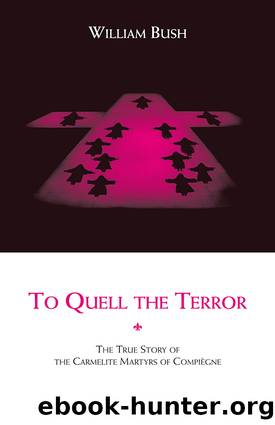TO QUELL THE TERROR by William Bush

Author:William Bush
Language: eng
Format: epub
Publisher: ICS Publications
ix
REGARDLESS OF WHEN Madame Lidoineâs carol was first sung, it sprang from the same source as their act of consecration. It was Mother Teresa of St. Augustineâs spiritual reaction as a consecrated Christian woman to the chaos into which France had been plunged since the night of August 10, 1792, when the king and royal family had fled to the National Assembly, seeking protection from the mob storming the Tuileries Palace. The National Assembly, instead of receiving them as the endangered First Family of Franceâs much-touted constitutional monarchy, locked them up in the Temple.
Three weeks later the September massacres announced the unchaining of those dark, malevolent forces at work in France since the beginning of the Revolution. The definitive expulsion of all religious from convents and monasteries immediately followed.
These dark forces launched by the September massacres were even more blatantly evident by the end of 1792. By the spring of 1793, they had proven powerful enough to reshape official French justice with a heretofore unknown creation: the Revolutionary Tribunal. This Tribunal, under the cloak of legality provided by its creation, gave the revolutionary government complete freedom to perpetrate a reign of terror through indiscriminate mass executions.
The Revolutionary Tribunal was in fact the brainchild of Georges Jacques Danton, the thirty-four-year-old Minister of Justice. Though he had sanctioned the September massacres, he was sensitive to the political damage done to revolutionary France by foreign criticism of such freelance slaughter. An official, legal structure must therefore be created to allow for continuing the terrorism of mass executions, thus ensuring the Revolutionâs success through ever-greater audacity. What Danton did not foresee, however, was that he himself would be ensnared by his own audacious creation. A scarce year later, on April 5, 1794, he became the Revolutionary Tribunalâs most notable nonroyal victim.
The terrorism Danton favored proved as insensitive to the dead as to the living. It was as if everything human, dead or alive, had to feel the impact of the new orderâs fanatical championing of âliberty, equality, fraternity.â Long before 1793, with its desecration of the tombs in the royal basilica at Saint-Denis, and even prior to the storming of the Bastille, profanation of the dead had become a mark of the revolutionary spirit abroad. The macabre orgy of profanation and pillage at Saint-Denis in October of 1793 did not spare even the chaste remains of Madame Louise of France. Expressly sought out in the cemetery of Saint-Denisâs Carmel at the end of that ghoulish operation, they were disinterred and pitched into the common pit with the rest of Franceâs âmost Christianâ royal house, to be covered with quicklime. Christianityâs power to transcend birth and royal station was meaningless to the inflamed patriots.
Profanation of the dead in revolutionary France went beyond the mere parading of human heads. As we have seen, it included the mutilation of bodies and, on occasion, even cannibalism. The bloodbath of the September massacres thus only provided a disordered foretaste of the legalized mass shedding of blood ordered by the Revolutionary Tribunal.
Download
This site does not store any files on its server. We only index and link to content provided by other sites. Please contact the content providers to delete copyright contents if any and email us, we'll remove relevant links or contents immediately.
| Africa | Americas |
| Arctic & Antarctica | Asia |
| Australia & Oceania | Europe |
| Middle East | Russia |
| United States | World |
| Ancient Civilizations | Military |
| Historical Study & Educational Resources |
Magic and Divination in Early Islam by Emilie Savage-Smith;(1194)
Ambition and Desire: The Dangerous Life of Josephine Bonaparte by Kate Williams(1084)
Operation Vengeance: The Astonishing Aerial Ambush That Changed World War II by Dan Hampton(985)
What Really Happened: The Death of Hitler by Robert J. Hutchinson(867)
London in the Twentieth Century by Jerry White(844)
Time of the Magicians by Wolfram Eilenberger(842)
Twilight of the Gods by Ian W. Toll(810)
The Japanese by Christopher Harding(795)
Papillon by Henry Charrière(792)
Lenin: A Biography by Robert Service(778)
The Devil You Know by Charles M. Blow(777)
Twelve Caesars by Mary Beard(764)
Freemasons for Dummies by Hodapp Christopher;(747)
The Churchill Complex by Ian Buruma(729)
Napolean Hill Collection by Napoleon Hill(701)
The Enlightenment by Ritchie Robertson(690)
Henry III by David Carpenter;(685)
Bohemians, Bootleggers, Flappers, and Swells: The Best of Early Vanity Fair by Bohemians Bootleggers Flappers & Swells- The Best of Early Vanity Fair (epub)(681)
The Rise and Triumph of the Modern Self by Unknown(653)
